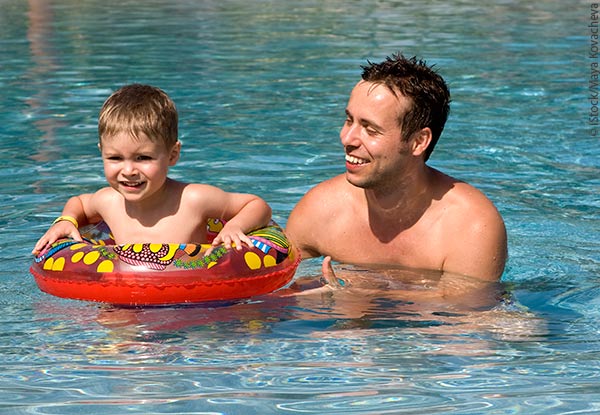Summertime typically brings hot weather and family vacations. Swimming and playing in water can be a big part of summer plans! However, playing with water is a sensory-filled activity. For some it is full of fun; for others it can lead to panic, apprehension, or even meltdowns. With a little preparation you can be sure that your child’s next water outing or swim lesson is a success. Here are some tips:
Choose a Swimsuit Together
The first thing that children need for a positive swim experience is to feel comfortable with their bathing suit. Always have your child participate in the selection of a swimsuit and practice wearing it before heading to the pool or beach. Some bathing suits are too tight, some too loose. Know your child’s preference in clothing and try to find the best match. A two-piece suit may look adorable on a little girl but the feeling of inconsistent pressure on her body may keep her from transitioning to the pool or the water activity. Does your son like to wear loose-fitting or tight clothing? This may help to know if a Speedo-type swimsuit or swim trunks is the right choice. Another option could be wearing a short-sleeve swim shirt for those who do not like to have their skin exposed; UV shirts are also great for sun protection.
Build Confidence
Transitioning from the side of the pool, or water source, to the water can be stressful due to the change in texture and stability. For kids who need to have their feet on the ground for balance and positioning, entering the water can be a worry. Help your children transition to the water by holding them in your arms or allowing them to hold a floatation device, such as a kickboard. Wearing some type of floatation vest on their body can also give them the pressure security they need while experiencing the water and movement. (Never use a device like this to ensure safety, however.) Wearing water shoes may help your child with the transition from the ground to the water. Also, wearing water fins on the feet help with position sense and movement.
Prepare for Splashing
Once your child gets in, there will always be that unexpected splashing of water on the face, which may cause discomfort and avoidance. If you know your child doesn’t like to have water poured over the head with hair washing, you can practice this feeling before you go swimming by making up games in the shower or tub to get him or her used to the sensation. Let your children explore the sensation by pouring water on a toy and then on themselves. Wearing goggles or a face mask can also help in giving pressure to the face, as well as creating a visual boundary. Practice using these also in the tub before heading to the beach or pool.
Acclimating to Water Temperature
The temperature of the water can keep a child from entering. Teach your child to put feet in first and then gradually submerge legs, waist, hands and arms, and upper body and head. Letting your child know what to expect by communicating how the water feels for you can help with the transition. Discussing a memory of another time that they felt this same temperature can help produce a similar feeling and reassure your child. Also, visual distractions or holding your child can help.
When in Crowded Pools or Water Parks
Swimming can be overstimulating, especially in a crowded pool or a busy water park. Letting your child watch, listen, and feel from the sidelines before entering the water can help with the transition and build confidence. Try to find an area in the water that allows for postural boundaries and limited unexpected changes. Slow transitions make for a much happier overall experience. Just because your child does well in one water environment does not mean the skill transfers to a new water experience! Be aware of your own child’s reaction to the sensations and movement to help make the experience a successful one.
Safety First
Safety is very important when water is involved, and consistent boundaries are necessary for helping your child learn the rules of the water. Never leave your children unattended, even though you feel they are safe and doing well. A sudden change in the sensations or movements can change the response to the activity.
By following these simple tips swimming and water play will build confidence for your child, and be a fun and enjoyable experience for the whole family.
Deanne Kelly, BS, OTR/L is an occupational therapist at Parents Place and has over 30 years of experience providing therapeutic intervention for children from birth to young adulthood. She specializes in developmental disabilities, attention deficit disorders, learning disabilities, and sensory processing challenges. She can be reached at 650-931-1854 or [email protected].

